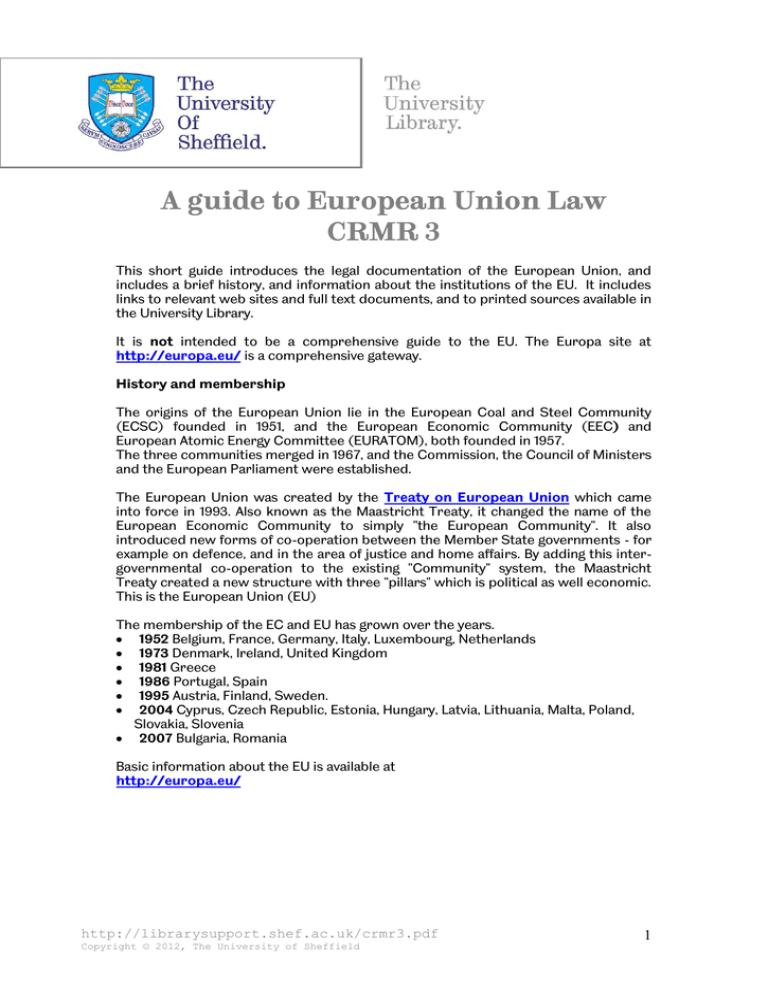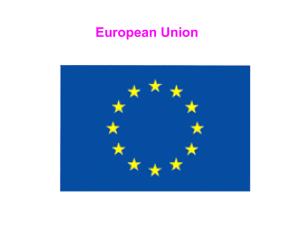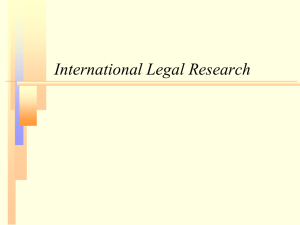A guide to European Union Law CRMR 3
advertisement

A guide to European Union Law CRMR 3 This short guide introduces the legal documentation of the European Union, and includes a brief history, and information about the institutions of the EU. It includes links to relevant web sites and full text documents, and to printed sources available in the University Library. It is not intended to be a comprehensive guide to the EU. The Europa site at http://europa.eu/ is a comprehensive gateway. History and membership The origins of the European Union lie in the European Coal and Steel Community (ECSC) founded in 1951, and the European Economic Community (EEC) and European Atomic Energy Committee (EURATOM), both founded in 1957. The three communities merged in 1967, and the Commission, the Council of Ministers and the European Parliament were established. The European Union was created by the Treaty on European Union which came into force in 1993. Also known as the Maastricht Treaty, it changed the name of the European Economic Community to simply "the European Community". It also introduced new forms of co-operation between the Member State governments - for example on defence, and in the area of justice and home affairs. By adding this intergovernmental co-operation to the existing "Community" system, the Maastricht Treaty created a new structure with three "pillars" which is political as well economic. This is the European Union (EU) The membership of the EC and EU has grown over the years. 1952 Belgium, France, Germany, Italy, Luxembourg, Netherlands 1973 Denmark, Ireland, United Kingdom 1981 Greece 1986 Portugal, Spain 1995 Austria, Finland, Sweden. 2004 Cyprus, Czech Republic, Estonia, Hungary, Latvia, Lithuania, Malta, Poland, Slovakia, Slovenia 2007 Bulgaria, Romania Basic information about the EU is available at http://europa.eu/ http://librarysupport.shef.ac.uk/crmr3.pdf Copyright © 2012, The University of Sheffield 1 The Institutions of the EU There are numerous other smaller EU organisations, but these are the key institutions The Council of the European Union The Council is the main decision making body of the EU, although it shares this function with the European Parliament. They also share responsibility for the EU budget. The Council is composed of representatives of each national government at ministerial level, authorised to make commitments on behalf of their government. Who attends might depend on the issue being discussed. The Presidency of the Council rotates every six months. Meetings usually take place in Brussels, but may be in other places. The Council has its own web site http://www.consilium.europa.eu/ European Commission The Commission is based in Brussels, is politically independent, and could be described as the Civil Service of the EU. It is answerable to the European Parliament. The Commission proposes legislation, and manages EU policy and budget. There are 27 Commissioners (one for each member state) appointed every 5 years after elections to the European Parliament, and around 24,000 civil servants who carry out the day to day work. Specific areas of policy are looked after by different Directorates General. The Commissions web site is http://ec.europa.eu/index_en.htm European Parliament The European Parliament represents the citizens of the EU, and shares legislative and budgetary responsibility with the Council. It has its own website http://www.europarl.europa.eu/portal/en The Parliament meets in Strasbourg in France, committee meetings are held in Brussels, and its Secretariat is based in Luxembourg. Court of Justice & Court of First Instance The Court ensures that EU legislation is interpreted and applied in the same way in all member states. The Court of Justice is composed of one judge from each member state, (27 at present) but can sit as a Grand Chamber of 11 judges. The judges are assisted by 8 Advocates-General, who present opinions to the Court. The judges and advocates are usually former members of the highest national courts of member states. The Court of First Instance was established in 1989 to help cope with the volume of work by dealing with certain types of case. It also has one judge from each member state. (No AG’s.) The Court is based in Luxembourg. Its web site is http://curia.europa.eu/jcms/jcms/j_6/ EU legal materials The EUR-Lex site http://eur-lex.europa.eu/en/index.htm provides direct free access to EU law. General information on EU documentation is available from http://europa.eu/ Sources of EU Information in the UK, including European Documentation Centres (EDC’s) are listed at http://ec.europa.eu/unitedkingdom/information/eu_information_in_the_uk/index_en.h tm Sheffield Hallam University has a European Documentation Centre in the Adsetts Learning Centre. http://librarysupport.shef.ac.uk/crmr3.pdf Copyright © 2012, The University of Sheffield 2 Primary legislation – Treaties The Treaties are considered to be the "constitution" of the European Union. They created, gave authority to and imposed restrictions on the power of the institutions. They imposed binding obligations on the signatory states particularly with regard to the supremacy of the Treaties and enacted European Community legislation over national laws. The Treaties form part of the national law of each member state. Consolidated versions of the treaties are available on EUR-Lex at http://europa.eu. The official published source for the Treaties is the Official Journal of the European Union, available in the University Library, shelfmark ERC 349.401401 OFF. Print copies of some of the treaties are also available, shelfmark ERC 349.401 Secondary legislation: Regulations, directives, decisions, recommendations Regulations take effect in all member states without the need for national implementation measures. e.g. Commission Regulation (EC) No. 1965/2004 of 14 January 2004 establishing a system for the development and assignment of unique identifiers for genetically modified organisms Official Journal L010, 16/01/2004 pp. 5 – 10 Directives must be implemented by all member states within a given timescale, using their own legislative systems. e.g. Directive 2004/23/EC of the European Parliament and of the Council of 31 March 2004 on setting standards of quality and safety for the donation, procurement, testing, processing, preservation, storage and distribution of human tissues and cells. Official Journal L102 07/04/04 pp 48 -58. Member states must make laws to comply with this directive by 7 April 2006, 2 years after it came into force. Information on national implementing measures for Directives is available on EURLex. In the UK, Directives are often implemented by Statutory Instrument. For example, the Money Laundering Regulations 2003 (SI 2003/3075) implemented EU Directive 2001/97. Halsbury’s Statutory Instruments, available in the Library, has an EC Legislation Implementation volume that is very useful for tracing these. Decisions are addressed to individuals or member states, and are binding upon those to whom they are addressed. They do not normally create generally applicable EU law. Recommendations and opinions have no legally binding force, and could be defined as rules of conduct. Finding regulations, directives, decisions and recommendations These materials are available electronically on EUR-Lex the free database of EU law. The official source is the printed version of the Official Journal of the European Union (L Series), available in the university Library. Annual indexes are published. The Official Journal is also available electronically on EUR-Lex Eur-Lex has a specific section on legislation that is in force, and the search form allows you to restrict your search to legislation in force. http://librarysupport.shef.ac.uk/crmr3.pdf Copyright © 2012, The University of Sheffield 3 Legal databases such as LexisLibrary and Westlaw also include EU legislation. Proposed legislation Proposals for new legislation, or for amendments, are issued by the Commission of the EU as COM documents. e.g COM(2005)577 Amended proposal for a regulation of the European Parliament and of the council on medicinal products for paediatric use. COM documents are available on EUR-Lex. Case Law - European Court of Justice & Court of First Instance Every case filed at the European Court is given a registration number. Cases before the European Court of Justice are prefixed C, cases before the Court of First Instance are prefixed T. e.g. T-11/03 Elizabeth Afari v European Central Bank. A case may then take some time to progress through the Court, and a judgment may not be given until several years later, but it always keeps its original registration number. The official printed source for judgments is the European Court Reports – ECR. Publication of a judgment may take some time, because of the importance of getting accurate translations into all community languages. The European Court Reports are published annually in 2 volumes. Volume I covers cases heard in the Court of Justice, Volume II covers cases heard in the Court of First Instance. A typical citation might look like this: C-279/00 Commission v Italy, [2002] ECR I-1425. Judgments are freely available electronically on EUR-Lex, or on the Court of Justice web site http://curia.europa.eu/. However, the printed version is considered authoritative. EU case reports are also available on legal databases such as Westlaw and Lexis, and in various series of reports from commercial publishers, such as the Common Market Law Reports and All England European Cases. Current awareness As with any legal jurisdiction, European Union law changes rapidly. The Current Law Monthly Digest, available in the Library, is a useful current awareness tool. EUR-Lex has a news link from the home page that includes a selection of new documents and dossiers on topics of current interest. The Westlaw current awareness service includes EU materials Web links The Library Guide European Union in the Library and on the Internet contains more useful links. Further information For further information contact Maria Mawson [m.b.mawson@sheffield.ac.uk] who is the Academic Liaison Librarian for this subject. http://librarysupport.shef.ac.uk/crmr3.pdf Copyright © 2012, The University of Sheffield 4




